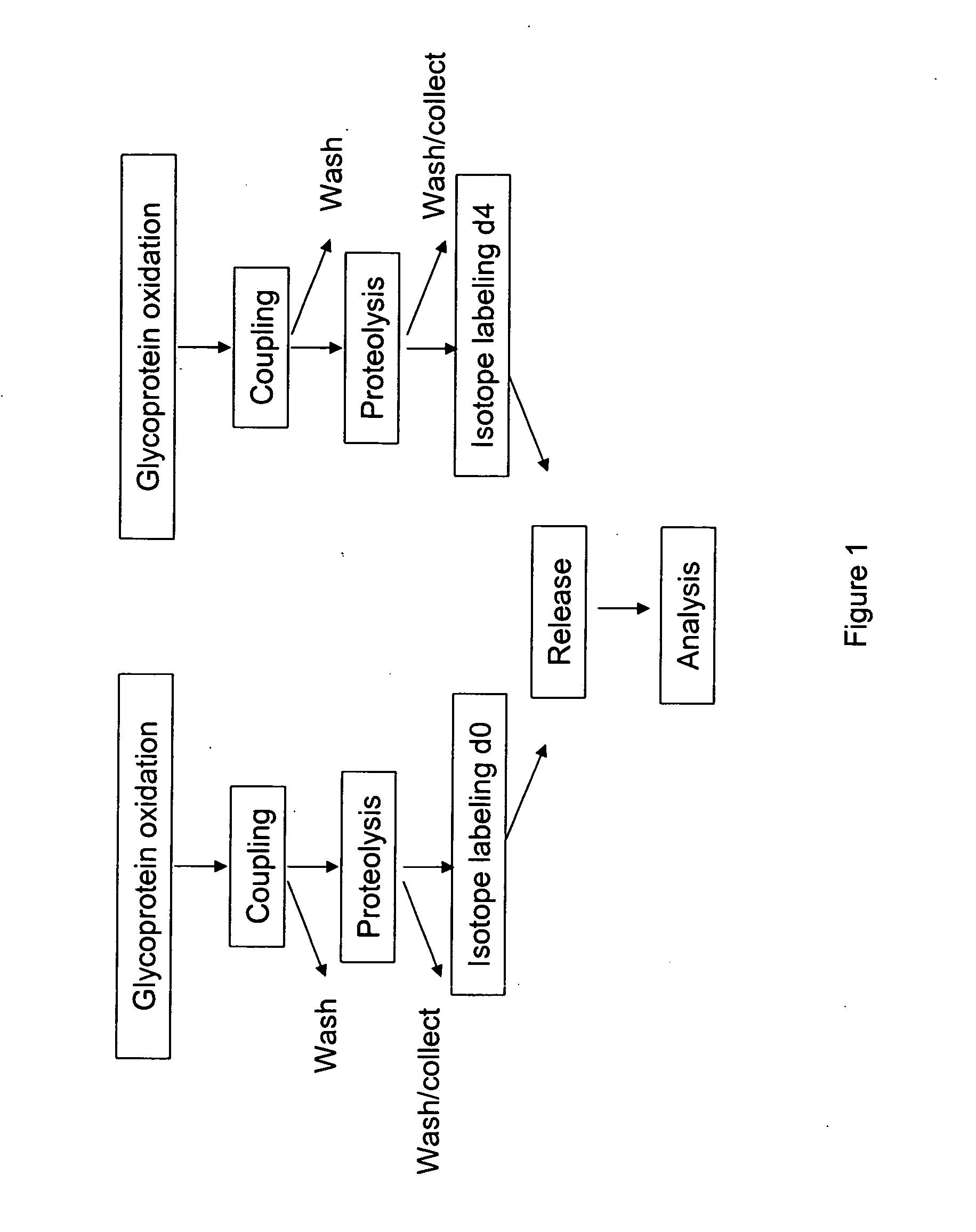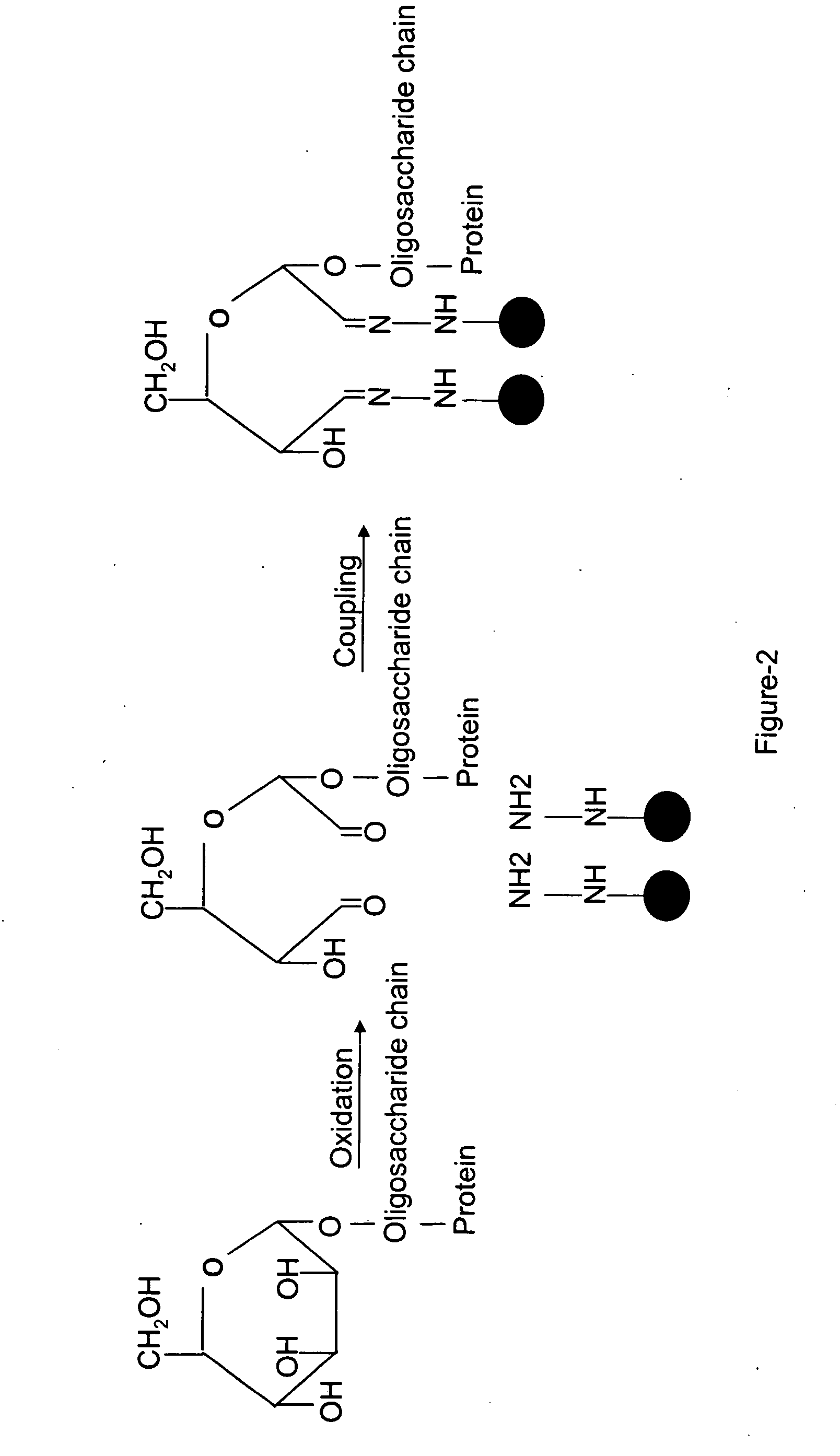Methods for quantitative proteome analysis of glycoproteins
a quantitative and proteome technology, applied in the field of proteomics, can solve the problems of complex studies on protein glycosylation, inability to predict the amount or activity of protein products, and inability to explain biological and clinical mechanisms
- Summary
- Abstract
- Description
- Claims
- Application Information
AI Technical Summary
Benefits of technology
Problems solved by technology
Method used
Image
Examples
example i
Quantitative Analysis of Glycopeptides
[0164] This example describes purification of glycopeptides and differential labeling with isotope tags.
[0165] An embodiment of a method of the invention is schematically illustrated in FIG. 1. The method can include the following steps: (1) Glycoprotein oxidation: Oxidation, for example, with periodate, converts the cis-diol groups of carbohydrates to aldehydes (FIG. 2); (2) Coupling: The aldehydes react with hydrazide groups immobilized on a solid support to form covalent hydrazone bonds (FIG. 2). Non-glycosylated proteins are removed; (3) Proteolysis: The immobilized glycoproteins are proteolyzed on the solid support. The non-glycosylated peptides are removed by washing and can be optionally collected for further analysis, whereas the glycosylated peptides remain on the solid support; 4) Isotope labeling: The α amino groups of the immobilized glycopeptides are labeled with isotopically light (d0, contains no deuteriums) or heavy (d4, contai...
example ii
Quantitative Glycopeptide Profiling in Human Blood Serum
[0173] This example describes profiling of glycoproteins in human blood serum.
[0174] To assess the potential of the glycopeptide capture method for serum protein profiling, the specificity and efficiency of conjugation was first determined. Human serum proteins were coupled to the hydrazide beads. Identical aliquots (1 μl) were removed from the sample before (“−beads”) or after capture of glycoproteins to hydrazide resin (“+beads”). The samples were separated by 9% sodium dodecyl sulfate-polyacrylamide gel electrophoresis (SDS-PAGE) and stained with silver (total protein stain) or with a glycoprotein-staining reagent (FIG. 4).
[0175] Isolation of glycopolypeptides was performed essentially as described in Example I. For analysis of serum samples, 2.5 ml of human serum (200 mg total protein) were changed to buffer containing 100 mM NaAc, 150 mM NaCl, pH 5.5 using a desalting column (Bio-Rad). Sodium periodate solution at 15 mM...
example iii
Quantitative Profiling of Glycoproteins Secreted by Macrophages
[0192] This example describes the preparation of secreted protein sample from stimulated RAW 264.7 mouse monocyte / macrophage cell line.
[0193] Briefly, 109 RAW cells were used. On day 1, cells were plated at a density of 2.5×105 cells / cm2 with 10 nM phorbol 12-myristate-13-acetate (PMA). On day 2, the media was removed, and new media was added without PMA. On day 3, the cells were washed three times with serum-free media.
[0194] Lipopolysaccharide (LPS) was added as stimulant to the experimental cells with serum-free, PMA-free media. The cells were incubated at 37° C. for 4 hours. The supernatant was removed, and the cells were centrifuged at 3,000×g for 5 minutes to remove cells and large debris. The supernatant was centrifuged at 100,000×g for 1 hour to remove debris.
[0195] The supernatant was concentrated with an 80 mL Centricon concentrator, with 300 mL concentrated to <1 mL for each condition. The final concentrat...
PUM
| Property | Measurement | Unit |
|---|---|---|
| pore-size | aaaaa | aaaaa |
| pH | aaaaa | aaaaa |
| concentration | aaaaa | aaaaa |
Abstract
Description
Claims
Application Information
 Login to View More
Login to View More - R&D
- Intellectual Property
- Life Sciences
- Materials
- Tech Scout
- Unparalleled Data Quality
- Higher Quality Content
- 60% Fewer Hallucinations
Browse by: Latest US Patents, China's latest patents, Technical Efficacy Thesaurus, Application Domain, Technology Topic, Popular Technical Reports.
© 2025 PatSnap. All rights reserved.Legal|Privacy policy|Modern Slavery Act Transparency Statement|Sitemap|About US| Contact US: help@patsnap.com



